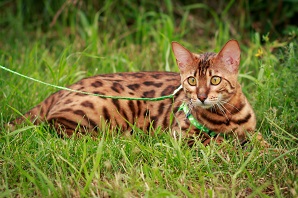What to know if you are buying a… Bengal Cat

There are many aspects that potential cat owners need to consider before acquiring a cat or kitten and each breed has their own unique personalities and health care needs.
Petplan takes a look at the origins, temperament and common health problems of the Bengal cat…
Name:
Bengal
Origins of the breed:
The Bengal cat originated through interbreeding the Asian Leopard cat with the domestic cat (starting with the Abyssinian, Burmese and Eqyptian Mau). This occurred in the 1970/80s as Dr Willard Centerwall attempted to transfer the Asian Leopard cats’ apparent immunity to Feline Leukaemia into their domestic cousins. The breed was recognised by The International Cat Association in 1983, in the UK in 1997 and finally received full championship status in 2005.
Lifespan:
The average lifespan is around 10 to 15 years.
Bengal Cat’s personality:
Bengal cats are very loving, loyal and a dedicated part of the family unit as they possess a good temperament with children. They are commonly very playful and enjoy interaction with people on a regular basis to show off their cheeky sense of humour and mischievous nature.
With an instinctive love of water they are often found drinking from taps or other water sources in the home, so keeping toilet lids down is advised. They love to interact and play with other cats and dogs and can be very talkative!
How much exercise a Bengal Cat needs:
The Bengal cat is a very active, inquisitive and intelligent cat. They love jumping on people, worktops, and love heights! They like to get involved with the daily lives of the family and love sticking their nose or paw into anything going on in the house or garden. Unrolling toilet rolls and learning to switch on lights are common Bengal activities. They also don’t like being left of their own for long – so if you work all day it’s best to get two so they can keep each other entertained.
Potential Bengal Cat health problems:
Bengal cats are generally strong and hardy, however, they do have some known health problems:
Eye disease
Bengals can be susceptible to progressive retinal atrophy. This is a degenerative condition which sees the deterioration of the retinas leading to eventual blindness which typically occurs over a number of years. Unfortunately there is no cure for the condition, but responsible breeders should be breeding from cats that have tested negative for the disease.
Luxating patellas
Joint problems such as luxating patellas can also occur in Bengal cats.
In simple terms, this is a dislocation of the kneecaps which is often caused by a genetic malformation or trauma. There are four grades of patella luxation, with one being the least severe and four being the most.
This issue can usually be fixed through surgery and the cats can go on to have perfectly normal lives.
Cardiomyopathy
This is when the heart muscle thickens, limiting the amount of blood that the heart can pump. This can lead to blood clots and heart failure. The disease can be detected through a number of tests including ECG, x-ray and ultrasound. There are various drugs which can help manage the condition and delay progression.
As with all pets, it’s vital you have the right insurance to ensure your pet gets the best care possible. Visit Petplan’s cat insurance page to see which policy is right for your cat.
Have you got a Bengal Cat? Have you got advice for anyone considering getting one? Let us know in the comments below….

